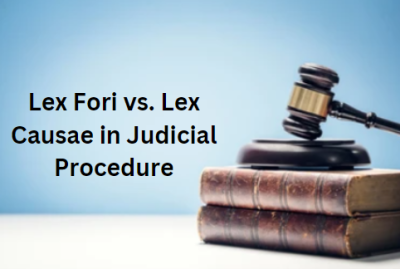INTRODUCTION
Judicial procedure is the process by which the competent local authorities resolve disputes between parties. Its object is twofold: (1) To regulate the exercise of the jurisdiction by local authorities and (2) To end a legal dispute based on substantive law. To accomplish these two objectives, there are rules of procedure that deal with the exercise of jurisdiction and are regulated by Lex Fori, as discussed above, and rules of procedure related to the substantive law that will be applied to the dispute. The second group of rules is not regulated by Lex Fori.
Instead, it is governed by the law that is applied to the merits of the dispute–Lex Causae. Thus, if a suit is commenced in Country A against a defendant domiciled in Country B, the law of Country A may have to be applied to all procedural acts that take place in Country A’s jurisdiction and the law of Country B to those acts–such as service and the collection of evidence–that take place in Country B.
[Image Sources: Shutterstock]
If the law of a third country is to be applied to the merits of the dispute — either because the parties have so determined or because the conflict of law rules of the original forum so require —this law must also be taken into account for some specific procedural matters. For example, if the law of Country C is to be applied to the merits of the case, this law will also determine which party carries the burden of proof. This is so because, in spite of its procedural nature, the burden of proof is inextricably linked to the substance of the case. In addition, because rules that determine which party carries the burden of proof establish legal presumptions regarding the rights that are being claimed, they are also tied to the merits of the case and should be regulated by the same system of law that applies to the merits.[i]
LEX CAUSAE: HISTORY
This rule was adopted by the 1980 Rome Convention on the Law Applicable to Contractual Obligations which states: The law governing the contract under this Convention applies to the extent that it contains, in the law of contract, rules which raise presumptions of law or determine the burden of proof. The Bustamante Code similarly states: “The law governing the offense or the legal relation constituting the subject of the civil or commercial suit determines upon whom the burden of proof rests.”[ii]
LEX CAUSAE: APPLICABILITY
Lex Causae shall also apply, as a rule, to the interest of the party to bring suit. In order to avoid setting the judicial machinery into motion in vain, procedural law generally requires that the plaintiff have a prima facie interest in the claim, be able to prove that he or she suffered injury, and show judicial intervention is required to minimize or end the injury. Standing must be verified in accordance with the Lex Causae. The second requirement for initiating a suit–legitimacy of the party– is also determined in accordance with the law that regulates the merits. Since an inquiry into the right which is at stake decides whether the plaintiff is the proper party to file the lawsuit and the defendant the proper party to fight the lawsuit, this issue can only be regulated by the substantive law applied to the merits of the case. Because an inquiry into capacity determines whether the plaintiff has the legal ability to sue in court, this issue can only be regulated by the substantive law applied to the merits of the case.
CONCLUSION
Additionally, the capacity to be in court–which is not a requirement of admissibility of a suit, but a requirement for the validity of any process–is also not evaluated according to Lex Fori, but rather is governed by the law that regulates the capacity of exercising rights in general. Statutes of limitation are equally outside the domain of the procedural law of the forum because they concern the ability to enforce the right in question. Therefore, statutes of limitation are subject to the same rule of law as the main subject of the case. Thus, the same law that regulates the act itself regulates the statute of limitation regarding a suit for the annulment of an act.
REFERENCES
[i]F. Bartin, De LeimpossibiliteDearrivere La Suppression Definitive Des Conflits des Lois (1897).
[ii]Convention on Private International Law (Bustamante Code), Feb. 20, 1928, 86 L.N.T.S. 254 (English version). This Convention was ratified by Bolivia, Brazil, Chile, Costa Rica, Cuba, the Dominican Republic, Ecuador, El Salvador, Guatemala, Haiti, Honduras, Nicaragua, Panama, Peru, and Venezuela.
Author: Ipsita Sinha, in case of any queries please contact/write back to us via email chhavi@khuranaandkhurana.com or at Khurana & Khurana, Advocates and IP Attorney.




